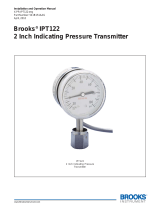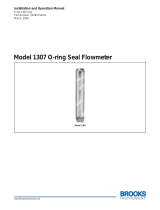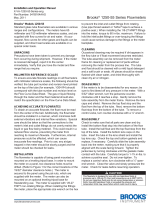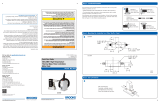Page is loading ...

Installation and Operation Manual Supplement
SM-VA-MT3809G-Alarms-eng
Part Number: 541B193AAG
April, 2014
Brooks
®
Model MT3809G
Metal Tube Variable Area Flowmeters
IEC 61508:2010 Safety Manual

Installation and Operation Manual Supplement
SM-VA-MT3809G-Alarms-eng
Part Number: 541B193AAG
April, 2014
ii
Model MT3809G
Essential Instructions
Read this page before proceeding!
Brooks Instrument designs, manufactures and tests its products to meet many national and international standards. These
products must be properly installed, operated and maintained to ensure they continue to operate within their normal
specifications. The following instructions must be adhered to and integrated into your safety program when installing, operating
and maintaining Brooks Instrument products.
• To ensure proper performance, use qualified personnel to install, operate, update, program and maintain the product.
• Read all instructions prior to installing, operating and servicing the product. If this instruction manual is not the correct
manual, please see back cover for local sales office contact information. Save this instruction manual for future reference.
WARNING
Do not operate this instrument in excess of the specifications listed in the Instruction and Operation Manual. Failure to
heed this warning can result in serious personal injury and / or damage to the equipment.
• If you do not understand any of the instructions, contact your Brooks Instrument representative for clarification.
• Follow all warnings, cautions and instructions marked on and supplied with the product.
• Install your equipment as specified in the installation instructions of the appropriate instruction manual and per applicable
local and national codes. Connect all products to the proper electrical and pressure sources.
• Operation: (1) Slowly initiate flow into the system. Open process valves slowly to avoid flow surges. (2) Check for leaks
around the flow meter inlet and outlet connections. If no leaks are present, bring the system up to the operating pressure.
• Please make sure that the process line pressure is removed prior to service. When replacement parts are required,
ensure that qualified people use replacement parts specified by Brooks Instrument. Unauthorized parts and procedures
can affect the product's performance and place the safe operation of your process at risk. Look-alike substitutions may
result in fire, electrical hazards or improper operation.
• Ensure that all equipment doors are closed and protective covers are in place to prevent electrical shock and personal
injury, except when maintenance is being performed by qualified persons.
European Pressure Equipment Directive (PED)
All pressure equipment with an internal pressure greater than 0.5 bar (g) and a size larger than 25mm or 1" (inch) falls under
the Pressure Equipment Directive (PED).
• The Specifications Section of this manual contains instructions related to the PED directive.
• Meters described in this manual are in compliance with EN directive 97/23/EC.
• All Brooks Instrument Flowmeters fall under fluid group 1.
• Meters larger than 25mm or 1" (inch) are in compliance with PED category I, II or III.
• Meters of 25mm or 1" (inch) or smaller are Sound Engineering Practice (SEP).

Installation and Operation Manual Supplement
SM-VA-MT3809G-Alarms-eng
Part Number: 541B193AAG
April, 2014
iii
Model MT3809G
European Electromagnetic Compatibility (EMC)
The Brooks Instrument (electric/electronic) equipment bearing the CE mark has been successfully tested to the regulations of
the Electro Magnetic Compatibility (2004/108/EC (EMC directive 89/336/EEC)).
Special attention however is required when selecting the signal cable to be used with CE marked equipment.
Quality of the signal cable, cable glands and connectors:
• Brooks Instrument supplies high quality cable(s) which meets the specifications for CE certification.
• If you provide your own signal cable you should use a cable which is overall completely screened with a 100% shield.
• “D” or “Circular” type connectors used should be shielded with a metal shield. If applicable, metal cable glands must be
used providing cable screen clamping.
• The cable screen should be connected to the metal shell or gland and shielded at both ends over 360 Degrees.
• The shield should be terminated to an earth ground.
• Card Edge Connectors are standard non-metallic. The cables used must be screened with 100% shield to comply with CE
certification.
• The shield should be terminated to an earth ground.
• For pin configuration : Please refer to the enclosed Instruction Manual.
ESD (Electrostatic Discharge)
CAUTION
This instrument contains electronic components that are susceptible to damage by static electricity. Proper handling
procedures must be observed during the removal, installation or other handling of internal circuit boards or devices.
Handling Procedure:
1. Power to unit must be removed.
2. Personnel must be grounded, via a wrist strap or other safe, suitable means before any printed circuit card or other
internal device is installed, removed or adjusted.
3. Printed circuit cards must be transported in a conductive container. Boards must not be removed from protective
enclosure until immediately before installation. Removed boards must immediately be placed in protective container
for transport, storage or return to factory.
Comments:
This instrument is not unique in its content of ESD (electrostatic discharge) sensitive components. Most modern electronic
designs contain components that utilize metal oxide technology (NMOS, SMOS, etc.). Experience has proven that even small
amounts of static electricity can damage or destroy these devices. Damaged components, even though they appear to
function properly, exhibit early failure.

Installation and Operation Manual Supplement
SM-VA-MT3809G-Alarms-eng
Part Number: 541B193AAG
April, 2014
iv
Model MT3809G
Dear Customer,
We appreciate this opportunity to service your flow measurement and control requirements with an integrated
system from Brooks Instrument. Every day, flow customers all over the world turn to Brooks Instrument for
solutions to their gas and liquid low-flow applications. Brooks provides an array of flow measurement and control
products for various industries from biopharmaceuticals, oil and gas, fuel cell research and chemicals, to medical
devices, analytical instrumentation, semiconductor manufacturing, and more.
The Brooks product you have just received is of the highest quality available, offering superior performance,
reliability and value to the user. It is designed with the ever changing process conditions, accuracy requirements
and hostile process environments in mind to provide you with a lifetime of dependable service.
We recommend that you read this manual in its entirety. Should you require any additional information concerning
Brooks products and services, please contact your local Brooks Sales and Service Office listed on the back cover
of this manual or visit www.BrooksInstrument.com
Yours sincerely,
Brooks Instrument

Installation and Operation Manual Supplement
SM-VA-MT3809G-Alarms-eng
Part Number: 541B193AAG
April, 2014
v
Model MT3809G
Contents
Contents .......................................................................................................................................................v
1. Introduction..............................................................................................................................................1
1.1. Documentation and Standards..................................................................................................1
1.2. Terms and Definitions................................................................................................................1
1.3. Theory of Operation...................................................................................................................3
1.4. Model Code information for Safety Instrumented System (SIS) Inductive Alarm Switches......4
2. Safety Function Specification ................................................................................................................1
2.1. Installation and Operation Limits ...............................................................................................1
2.2. Failure Modes, Effects and Diagnostics Analysis (FMEDA) .....................................................1
2.3. Description of failure categories ................................................................................................1
3. Safety Related Characteristics...............................................................................................................1
3.1. Assumptions and planning ........................................................................................................1
3.2. FMEDA results...........................................................................................................................2
4. Operation and Maintenance ...................................................................................................................1
4.1. Lifetime ......................................................................................................................................1
4.2. Proof-test ...................................................................................................................................2

Installation and Operation Manual Supplement
SM-VA-MT3809G-Alarms-eng
Part Number: 541B193AAG
April, 2014
vi
Model MT3809G
THIS PAGE WAS
INTENTIONALLY
LEFT BLANK

Installation and Operation Manual Supplement
SM-VA-MT3809G-Alarms-eng
Part Number: 541B193AAG
April, 2014
1-1
Section 1 – Introduction
Model MT3809G
1. Introduction
IEC 61508 is a basic safety publication of the International Electrotechnical Commission
(IEC) and has been widely accepted as the basis for the specification, design and
operation of safety instrumented systems.
The safety function of the MT3809G Variable Area Flowmeter provides a flowrate alarm
indication when the flowrate is above or below a specified trip point within specified
accuracy.
This manual provides the necessary requiments for integration of the MT3809G with
Inductive Alarms into an IEC 61508 safety instrumented system.
1.1. Documentation and Standards
IEC 61508-2: ed2, 2010 – Functional Safety of Electrical/Electronic/Programmable
Electronic Safety-Related Systems
Electrical & Mechanical Component Reliability Handbook, 2
nd
edition, 2008 – exida LLC,
ISBN 978-0-9727243-6-6
X-VA-MT3809G-MT3810G – Brooks Instrument Models MT3809G and MT3810G Metal
Tube Variable Area Flowmeters Instruction and Operation Manual
DS-VA-MT3809G - Brooks Instrument MT3809G Series Metal Tube Variable Area
Flowmeters Data Sheet
1.2. Terms and Definitions
Basic Safety Freedom from unacceptable risk of harm.
BPCS Basic Process Control System – a system which responds to input
signals from the process, its associated equipment, other
programmable systems and/or an operator and generates output
signals causing the process and its associated equipment to
operate in the desired manner but which does not perform any
safety instrumented functions with a claimed SIL greater than or
equal to 1.
Fail-safe State State where switch output is in the state corresponding to an alarm
condition. In this condition the switch contacts will normally be

Installation and Operation Manual Supplement
SM-VA-MT3809G-Alarms-eng
Part Number: 541B193AAG
April, 2014
1-2
Section 1 – Introduction
Model MT3809G
open.
Fail Dangerous Failure that does not respond to an input from the process (i.e. not
switching to the fail-safe state).
Fail Dangerous
Detected
Failure that is dangerous but is detected.
Fail Dangerous
Undetected
Failure that is dangerous and that is not detected.
Fail No Effect Failure of a component that is part of the safety function but that
has no effect on the safety function.
Fail Safe Failure that causes the switch to go to the defined fail-safe state
without an input from the process.
FMEDA Failure Modes, Effects, and Diagnostics Analysis.
Functional Safety Part of the overall safety relating to the process and the BPCS
which depends on the correct functioning of the SIS and other
protection layers.
HFT Hardware Fault Tolerance.
PFDAVG Average Probability of Failure on Demand.
SFF Safe Failure Fraction – a fraction of the overall random failure rate
of a device that results in either a safe failure or a detected
dangerous failure.
SIF Safety Instrumented Function – a safety function with a specified
SIL which is necessary to achieve functional safety. Typically a set
of equipment intended to reduce the risk due to a specified hazard
(a safety loop).
SIL Safety Integrity Level – a discrete level (one out of four) for
specifying the safety integrity requirements of the safety
instrumented functions to be allocated to the safety instrumented
systems. SIL 4 has the highest level of safety integrity, and SIL 1
has the lowest level.
SIS Safety Instrumented System – an instrumented system used to
implement one or more safety instrumented functions. An SIS is
composed of any combination of sensors, logic solvers, and final
elements.

Installation and Operation Manual Supplement
SM-VA-MT3809G-Alarms-eng
Part Number: 541B193AAG
April, 2014
1-3
Section 1 – Introduction
Model MT3809G
1.3. Theory of Operation
The MT3809G Metal Tube Variable Area Flowmeter is an instrument used to measure
the flow rate of liquids and gases. Its operation is based on the on the variable area
principle, where flow raises a float in a tapered tube increasing the area for passage of
the flow. The float will reach a stable position when the force exerted by the flowing fluid
+ the buoyancy equals the gravitational force. A change in flow rate upsets this force
balance and will move up or down the float until it again reaches a position where the
forces are in balance.
When the flow is outside a flow band set by means of the low flow- and high flow
inductive alarm switches, a trip-low or trip-high signal will be provided.
For details, please refer to the Brooks Instrument Models MT3809G and MT3810G Metal
Tube Variable Area Flowmeters Instruction and Operation Manual (X-VA-MT3809G-
MT3810G)
Figure 1
Low- and High Flow Inductive Alarm setting

Installation and Operation Manual Supplement
SM-VA-MT3809G-Alarms-eng
Part Number: 541B193AAG
April, 2014
1-4
Section 1 – Introduction
Model MT3809G
1.4. Model Code information for Safety Instrumented System (SIS) Inductive Alarm Switches
Brooks Instrument Models MT3809G equipped with Safety Instrumented System (SIS)
Inductive Alarm Switches are marked with a code B, C, F, G, K or L on position XV of the
instrument model code. For detailed information refer to the Brooks Instrument MT3809G
Series Metal Tube Variable Area Flowmeters Data Sheet (DS-VA-MT3809G).

Installation and Operation Manual Supplement
SM-VA-MT3809G-Alarms-eng
Part Number: 541B193AAG
April, 2014
2-1
Section 2 –
Safety Function Specification
Model MT3809G
2. Safety Function Specification
The Safety Function of the Brooks Instrument MT3809G Flowmeter is to provide a flow
alarm indication when the flowrate is above or below a specified trip point within specified
accuracy.
2.1. Installation and Operation Limits
It is very important that the Brooks Instrument MT3809G Flowmeter is installed and
operated in accordance with the Brooks Instrument Models MT3809G and MT3810G
Metal Tube Variable Area Flowmeters Instruction and Operation Manual (X-VA-
MT3809G-MT3810G). If the use of the Brooks Instrument MT3809G Flowmeter is not in
compliance with these instructions and/or operated beyond limits, the SIL capability and
reliability data becomes invalid.
Under normal conditions the maximum operating life time will be 10 years.
2.2. Failure Modes, Effects and Diagnostics Analysis (FMEDA)
The design of the Brooks Instrument MT3809G Flowmeter with Inductive Alarms has
been assessed by means of a Failure Modes, Effects and Diagnostics Analysis
(FMEDA). A detailed report is available upon request (reference: “exida FMEDA report –
BRO 11-06-060 R001 V1, R2, May 24, 2013”)
The Safety Integrity Level (SIL) of an entire Safety Instrumented Function (SIF) must be
verified via a calculation of the PFD
AVG
considering redundant architectures, proof test
interval, proof test effectiveness, any automatic diagnostics, average repair time and the
specifies failure rates of all products included in the SIF
2.3. Description of failure categories
Fail-Safe State State where the output exceeds the user defined
threshold.
Fail Safe Failure that causes the output to go to the define fail-safe
state without a demand from the process

Installation and Operation Manual Supplement
SM-VA-MT3809G-Alarms-eng
Part Number: 541B193AAG
April, 2014
2-2
Section 2 –
Safety Function Specification
Model MT3809G
Fail Dangerous Failure that does not respond to a demand from the
process (i.e. being unable to go to the defined fail-safe
state).
Fail Dangerous Undetected Failure that is dangerous and that is not being diagnosed
by automatic diagnostics
Fail Dangerous Detected Failure that is dangerous but is being detected by
automatic diagnostics
No Effect Faulure of a component that is part of the safety function
but that has no effect on the safety function
The failure categories listed above expand on the categories listed in IEC 61508 which
are only safe and dangerous, both detected and undetected. In IEC 61508, edition 2010,
the No Effect failure cannot contribute to the failure rate of the safety function. Therefor
they are not used for the Safe Failure Fraction calculation needed when Route 2H failure
data is not available.

Installation and Operation Manual Supplement
SM-VA-MT3809G-Alarms-eng
Part Number: 541B193AAG
April, 2014
2-3
Section 2 –
Safety Function Specification
Model MT3809G


Installation and Operation Manual Supplement
SM-VA-MT3809G-Alarms-eng
Part Number: 541B193AAG
April, 2014
3-1
Section 3 –
Safety Related Characteristics
Model MT3809G
3. Safety Related Characteristics
3.1. Assumptions and planning
The following assumptions have been made during the Failure Modes, Effects and
Diagnostics Analysis of the Brooks Instrument MT3809G:
Only a single component failure will fail the entire MT3809G flowmeter.
Failure rates are constant; wear-out mechanisms are not included.
Propagation of failures is not relevant.
All components that are not part of the safety function and cannot influence the
safety function (feedback immune) are excluded.
The stress levels are average for an industrial environment and can be compared
to profile 4 for wetted parts and profile 3 for all others within operating and
environmental temperature limits.
Ambient Temp (°C) Profile General Description Profile acc.
IEC 60654-1
Average
(External)
Mean
(Inside box)
Temp cycle
(°C/365 days)
3
General field products - may
have moderate self heating and
are subjected to daily
temperature swings
C3 25 45 25
4
Unprotected mechanical field
products – may have minimal
self heating, are subject to daily
temperature swings and rain or
condensation
D1 25 30 35
4
Process wetted parts – typically
valve and sensor parts that are
process wetted
Per Installation and Operation instruction
Materials are compatible with process conditions

Installation and Operation Manual Supplement
SM-VA-MT3809G-Alarms-eng
Part Number: 541B193AAG
April, 2014
3-2
Section 3 –
Safety Related Characteristics
Model MT3809G
The device is installed per Brooks Instrument instructions
Flowmeters are installed such that the controlled substance will flow through the
flowmeter in the direction indicated by the flow arrow, located on the body
The flowmeters are generally applied in relative clean gas or liquid, therefor no
severe service has been considered in the analysis
Recommended calibration intervals are observed and used to implement proof
testing of the device
Repair and inspection intervals have to be based on the safety calculations
Modifications made without specific authorization of Brooks Instrument are strictly
prohibited
The parameters given by the FMEDA are considered as planning support. The
end-user is responsible for the overall functional safety of the application
The hardware that implements the safety function has been reviewed in
accordance with IEC 61508-2. Since there is no software involved IEC 61508-3
is not applicable
3.2. FMEDA results
The Brooks Instrument MT3809G flowmetes analysis resulted in suitability for use in SIL
2 safety functions in accordance with IEC 61508-2: 2010.
3809G Variable Area Flow Meter with Inductive Alarm
Device Type A
HFT 0
SIL 2
PFD
AVG
1.52E-03 for 1 Year
Failure Rate as per IEC 61508, ed2, 2010
Device λ
SD
λ
SU
λ
DD
λ
DU
SFF
3809G – VA Meter, (Trip High) 0 FIT 34 FIT 0 FIT 184 FIT 15.5%
3809G – VA Meter, (Trip Low) 0 FIT 140 FIT 0 FIT 77 FIT 64.6%

Installation and Operation Manual Supplement
SM-VA-MT3809G-Alarms-eng
Part Number: 541B193AAG
April, 2014
3-3
Section 3 –
Safety Related Characteristics
Model MT3809G
The failure rate data used for this analysis is as per route 2H approach according to
7.4.4.3 of IEC 61508. Therefore the 3809G Variable area Flowmeter meets the hardware
architectural constraints for up to SIL 2 with a single device when the listed failure rates
are used. For the listed PFDAVG valve a mission time of 10 years has been assumed
with a Mean Time To Restoration of 24 hours and proof test interval equals 1 year.

Installation and Operation Manual Supplement
SM-VA-MT3809G-Alarms-eng
Part Number: 541B193AAG
April, 2014
3-4
Section 3 –
Safety Related Characteristics
Model MT3809G
THIS PAGE WAS
INTENTIONALLY
LEFT BLANK

Installation and Operation Manual Supplement
SM-VA-MT3809G-Alarms-eng
Part Number: 541B193AAG
April, 2014
4-1
Section 4 –
Operation and Maintenance
Model MT3809G
4. Operation and Maintenance
4.1. Lifetime
According to section 7.4.9.5 of IEC 61508-2, a useful lifetime, based on experience,
should be assumed.
Although a constant failure rate is assumed by the probabilistic estimation method this
only applies provided that the useful lifetime of components is not exceeded. Beyond
their useful lifetime the result of the probabilistic calculation method is therefor
meaningless, as the probability of failure significantly increases with time. The useful
lifetime is highly dependent on the subsystem itself and the operating conditions.
This assumption of a constant failure rate is based on the bathtub curve. Therfore it is
obvious that the PFD
AVG
calculation is only valid for components that have this constant
and that the validity of the calculation is limited to the lifetime of each component.
It is the responsibility of the end user to maintain and operate the MT3809G flowmeter
per Brooks Instrument instructions. Furthermore regular inspection should show that all
components are clean and free from damage.
Based on general field failure data a useful period of approximately 10 years is expected
for the MT3809G flowmeter. When plant experience indicates a shorter useful lifetime
than indicated here, the number based on plant experience should be used.

Installation and Operation Manual Supplement
SM-VA-MT3809G-Alarms-eng
Part Number: 541B193AAG
April, 2014
4-2
Section 4 –
Operation and Maintenance
Model MT3809G
4.2. Proof-test
According to section 7.4.5.2 f) of IEC 61508-2 proof tests shall be undertaken to reveal
dangerous faults which are undetected by diagnostic tests. This means that it is
necessary to specify how dangerous undetected faults which have been noted during the
Failure Modes, Effects, and Diagnostic Analysis can be detected during proof testing.
Suggested Proof Test:
The suggested proof test consists of a two point calibration check per table below. The
suggested proof test will detect 92.1% of possible DU failures in the MT3809G flow meter
configured with Trip High application and 95.0% of possible DU failures in the MT3809G
flow meter configured with Trip Low application.
Step Action
1. Bypass the safety function and take appropriate action to avoid a false trip
2. Perform a two-point calibration of the flowmeter over the full working range
3. Remove the bypass and otherwise restore normal operation
/










